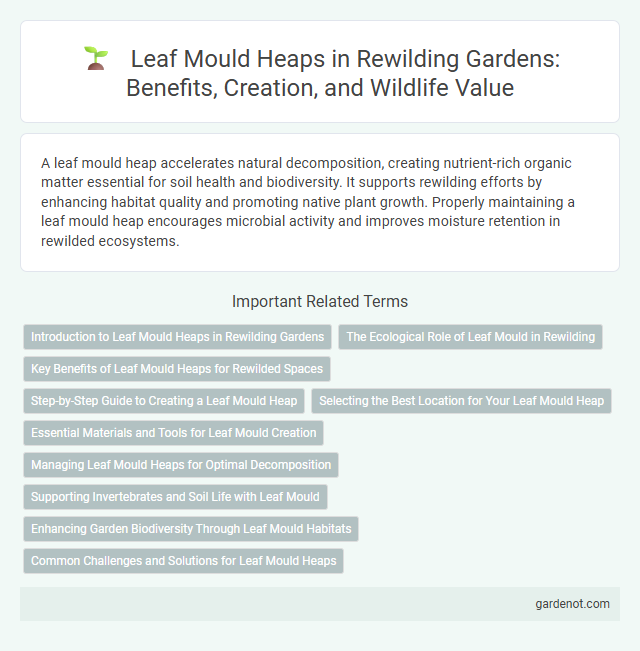A leaf mould heap accelerates natural decomposition, creating nutrient-rich organic matter essential for soil health and biodiversity. It supports rewilding efforts by enhancing habitat quality and promoting native plant growth. Properly maintaining a leaf mould heap encourages microbial activity and improves moisture retention in rewilded ecosystems.
Introduction to Leaf Mould Heaps in Rewilding Gardens
Leaf mould heaps play a crucial role in rewilding gardens by enhancing soil fertility through natural decomposition of fallen leaves. This organic material improves soil structure, moisture retention, and supports diverse microbial communities essential for native plant growth. Creating and maintaining leaf mould heaps fosters a sustainable ecosystem, promoting biodiversity and reducing the need for chemical fertilizers.
The Ecological Role of Leaf Mould in Rewilding
Leaf mould heaps play a vital ecological role in rewilding by enhancing soil fertility through the slow decomposition of fallen leaves, which creates a nutrient-rich humus layer. This organic matter improves soil structure, moisture retention, and supports diverse microbial communities essential for plant growth and ecosystem resilience. By promoting natural nutrient cycling and providing habitat for decomposers, leaf mould heaps foster biodiversity and contribute to the restoration of native habitats.
Key Benefits of Leaf Mould Heaps for Rewilded Spaces
Leaf mould heaps enhance soil structure and increase moisture retention, creating a fertile environment vital for rewilded spaces. They provide essential nutrients through slow decomposition, supporting diverse plant growth and promoting native biodiversity. The natural habitat created by leaf mould heaps attracts various microorganisms and invertebrates, crucial for ecosystem restoration and resilience.
Step-by-Step Guide to Creating a Leaf Mould Heap
Start by selecting a shaded, well-drained spot to pile collected fallen leaves, ensuring a heap size of at least one cubic meter for optimal heat retention. Layer the leaves loosely and occasionally moisten them to maintain dampness without waterlogging, promoting fungal activity essential for decomposition. Turn the heap every few months to aerate and accelerate the breakdown process, resulting in nutrient-rich leaf mould ready for garden use within 12 to 18 months.
Selecting the Best Location for Your Leaf Mould Heap
Choosing the ideal location for a leaf mould heap involves selecting a shaded, well-drained area away from high-traffic zones to ensure optimal decomposition. Positioning the heap near a water source facilitates regular moisture maintenance, which accelerates microbial activity essential for breaking down leaves. Avoid placing the heap directly on concrete or paved surfaces to prevent waterlogging and encourage natural aeration through soil contact.
Essential Materials and Tools for Leaf Mould Creation
A leaf mould heap requires essential materials such as a plentiful supply of fallen leaves, ideally from deciduous trees, which decompose into nutrient-rich organic matter. Tools including a garden fork or spade facilitate the turning and aeration of the heap, accelerating decomposition and preventing compaction. A breathable container or simply a designated garden corner with good drainage ensures optimal moisture levels for the microbial activity vital to leaf mould formation.
Managing Leaf Mould Heaps for Optimal Decomposition
Managing leaf mould heaps for optimal decomposition involves maintaining a balanced moisture level and regular aeration to promote microbial activity essential for breaking down leaves efficiently. Positioning heaps in shaded, well-drained areas helps preserve necessary humidity while preventing waterlogging, accelerating the transformation into nutrient-rich humus. Incorporating varied leaf types enhances biodiversity within the heap, increasing microbial diversity and improving the quality of the final leaf mould product.
Supporting Invertebrates and Soil Life with Leaf Mould
Leaf mould heaps create a habitat rich in organic matter that supports diverse invertebrate populations such as earthworms, beetles, and fungi. The gradual decomposition process enhances soil structure and nutrient availability, promoting healthier microbial and soil life essential for ecosystem resilience. Incorporating leaf mould into rewilding projects fosters biodiversity by sustaining the intricate food web and improving soil fertility naturally.
Enhancing Garden Biodiversity Through Leaf Mould Habitats
Leaf mould heaps create rich, organic matter that nourishes soil and supports diverse microbial life, fostering a healthy garden ecosystem. These habitats encourage the presence of beneficial insects, earthworms, and fungi that contribute to natural pest control and nutrient cycling. Incorporating leaf mould heaps into garden rewilding strategies promotes biodiversity and improves soil structure for sustainable plant growth.
Common Challenges and Solutions for Leaf Mould Heaps
Leaf mould heaps often face challenges such as slow decomposition due to low nitrogen content, moisture retention difficulties, and pest infestations like rodents or fungi. Solutions include regularly turning the heap to aerate and speed decomposition, adding nitrogen-rich materials like grass clippings to balance carbon-to-nitrogen ratio, and covering the heap with breathable tarps to maintain moisture while deterring pests. Monitoring moisture levels and ensuring proper site selection with good drainage also prevent anaerobic conditions and promote healthy microbial activity essential for effective leaf mould production.
Leaf mould heap Infographic

 gardenot.com
gardenot.com